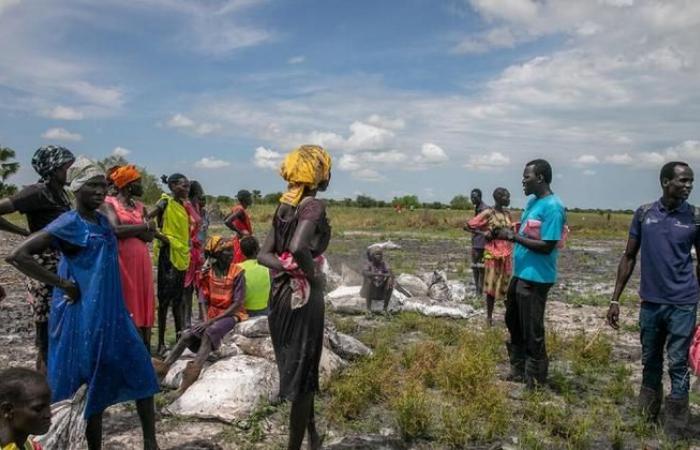Around 7.69 million people are likely to be in a food crisis (Phase 3 of the Integrated Food Security Classification Framework, IPC) or higher. This figure includes 2.53 million people likely to be in phase 4 (emergency food insecurity) and 63,000 people likely to be in phase 5 (catastrophe).
These alarming new data show that acute food insecurity and malnutrition are worsening due to the economic crisis, repeated climate shocks – mainly widespread flooding – as well as conflict and insecurity.
The influx of returnees and refugees fleeing the conflict in Sudan is exacerbating the situation and increasing pressure on an already fragile country.
Catastrophic hunger threatens returnees fleeing Sudan
According to the latest data from the Integrated Food Security Classification (IPC) Framework, more than 85% of returnees fleeing Sudan will be acutely food insecure during the upcoming lean season, which begins in April. They will also represent almost half of the people facing catastrophic hunger.
Conflict and climate crisis are the main driver of food insecurity in South Sudan
“Year after year we see hunger reaching some of the highest levels we have seen in South Sudan and when we look at the areas with the highest levels of food insecurity, it is clear that a cocktail of despair – conflict and climate crisis – is the main driver,” said Mary-Ellen McGroarty, the Representative of the United Nations World Food Program (WFP) in the country.
Between September and November 2024, the UN estimates that 6.3 million people (47% of the population analyzed) are classified in IPC phase 3 or in a higher phase (crisis or worse). Of this total, 1.71 million people are facing critical levels of acute food insecurity – classified as IPC Phase 4 (emergency) – and another 41,000 people are facing catastrophic levels of acute food insecurity or IPC Phase 5 (catastrophe).
Nearly 2.1 million children at risk of malnutrition
The Phase 5 (Catastrophe) population includes 10,000 people in Malakal County (Upper Nile State) and approximately 31,000 South Sudanese returnees who fled Sudan due to the ongoing conflict. Compared to the same period last year, this indicates an increase of around 500,000 people in phase 3 or higher.
Furthermore, nearly 2.1 million children are at risk of malnutrition, compared to 1.65 million previously. Children return to nutrition centers several times a year, as they continue to suffer from insufficient access to clean water and sanitation.
Illness is a major contributor to malnutrition and almost half of the children included in the data collected had been ill in the previous two weeks.
“Malnutrition is the end result of a series of crises, the most notable for South Sudan being the lack of sanitation and the prevalence of water-borne diseases, as well as severe food insecurity. “, said Hamida Lasseko, UNICEF Representative in this East African country.
UNICEF said it is deeply concerned that the number of children and mothers at risk of malnutrition will continue to increase unless efforts are made to prevent malnutrition. This involves tackling these root causes, alongside “providing immediate nutritional support to treat malnutrition in children who are at greater risk of dying”.






